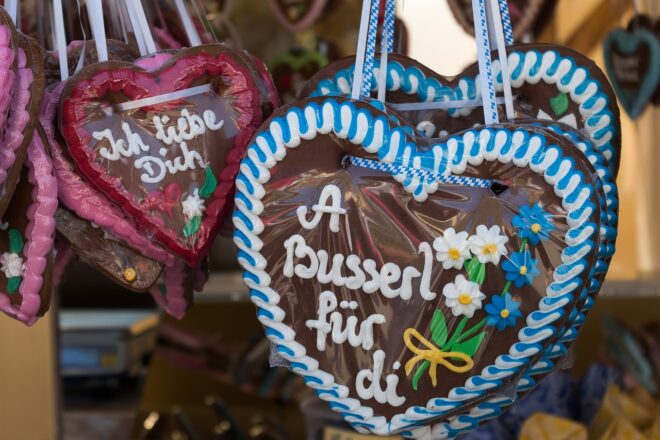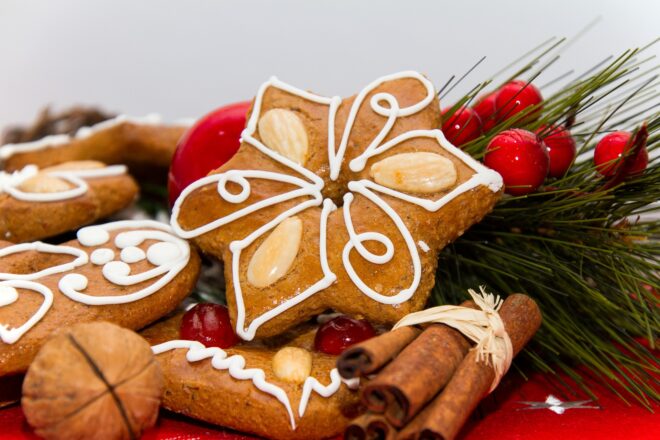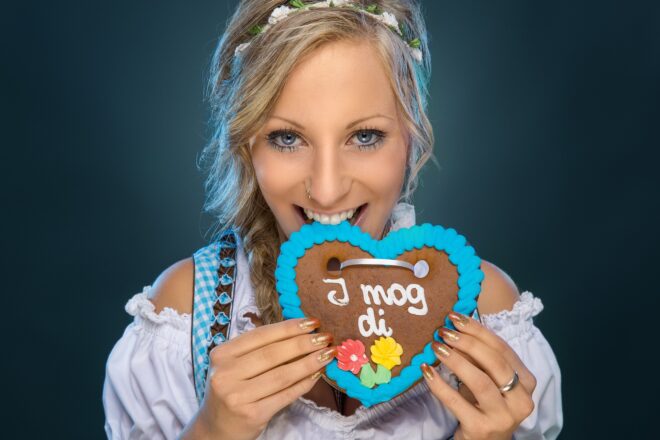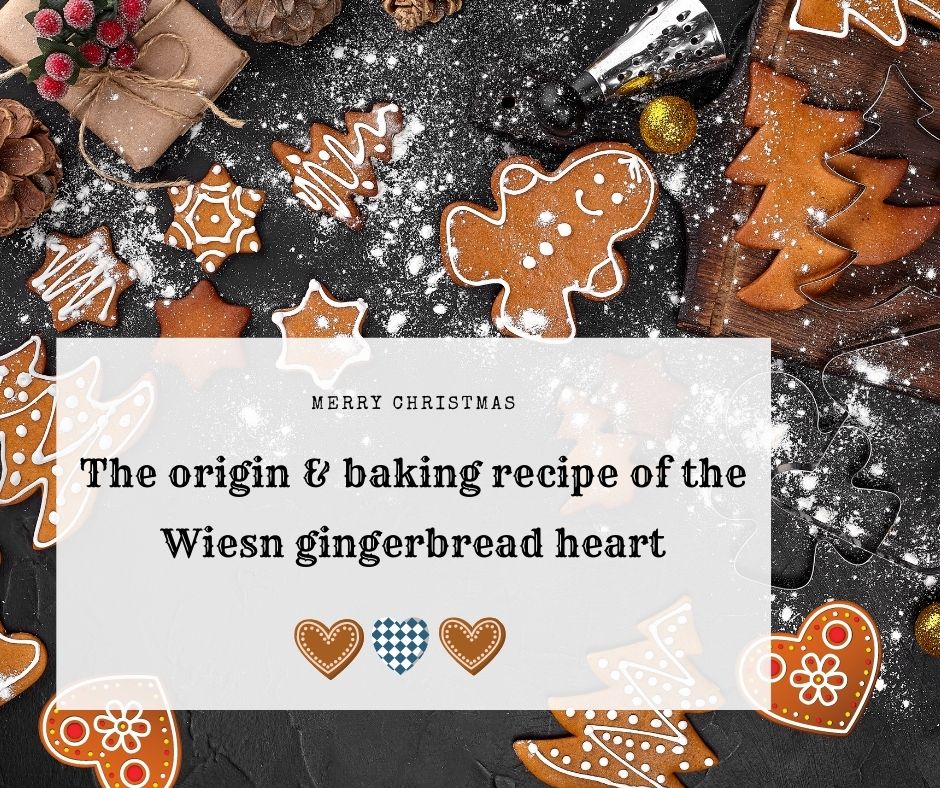Uncategorized
Wiesn gingerbread hearts – origin & recipe of the sweet treats
For many decades now, gingerbread has played a huge part in the tradition of Christmas food. The delicious smell from different spices and flavors at the Christmas market is enough to awaken the Christmas spirit in us. But the fine-tasting gingerbread is not only popular around Christmas time, but also as early as September at the Oktoberfest. Whether as a message of love, to tease with cheeky sayings or simply as a souvenir, the gingerbread heart is a big seller at the Wiesn. All over the Oktoberfest grounds, you’ll find candy stalls lavishly hung with these hearts. Hearts in the wildest colors or quite discreetly in blue and white, varying in size from small to very large. But why do you find gingerbread hearts everywhere at the Oktoberfest? In the following you will get to know the history of the Oktoberfest gingerbread hearts and a recipe for how you can easily make them yourself at home, for a very personal gift with your own little message.

What is the history and origin of gingerbread?
The first honey cakes were found as early as 350 BC: In ancient Egypt. The “honey-sweetened cakes” were found in graves. For this purpose, honey was spread on a cake, then baked along with the cake. At that time the gingerbread was consumed not only at Christmas time, but also during Easter or other occasions. At that time, gingerbread was considered a Lenten food and was served with strong beer. The Romans also baked the spicy treat, but not just to eat it, but because they believed in magical powers of the ingredients. Today’s gingerbread originated in Belgium; it was invented there in the 12th century in the municipality of Dinant. Subsequently, gingerbread manufacturers gradually settled in the 16th century at the main production centers in cities such as Nuremberg, Cologne, Augsburg and Ulm. These cities experienced great economic booms, making them great trade centers at that time and thus enabled the gingerbread bakers to be always sufficiently supplied with the rare spices from faraway countries. Also, the climatic conditions and ground conditions of these places were particularly good for beekeeping, because honey was very important for the production of gingerbread. The gingerbread was refined with nuts, almonds (a symbol of death and resurrection), spices and medicinal herbs. Anise, cardamom, nutmeg, coriander, cloves and black pepper were used. Since the pastries were considered healthy, healing, digestive and appetizing, they were baked and consumed in monasteries for a long time. Before the 16th century, the cakes were formed in clay, later in wooden and stone models also were already coated on wafers. Around 1840, with the invention of the steam engine, the pastry could be produced in larger quantities by machine.
Why is the gingerbread called “gingerbread”?
Where the gingerbread got its name is not entirely clear. The English term „gingerbread” most likely refers to the cakes’ spices and ingredients; one of which being ginger. In German, however, the origin of the name “Lebkuchen” is not exactly clear.
Why gingerbread at Christmas time?
As already mentioned, the sweet pastry, unlike today, was not considered a sweet treat, but rather a healing and Lenten food. This is why they were consumed especially in the weeks before Christmas, formerly a time of reflection, repentance and reversal. In medieval advent there was a tradition to switch roles on farms: maids and servants thus became Lords and the lordship served their servants. For this purpose, the gingerbread was baked and distributed to all the inhabitants of the house, to guests and to the poor.

How did gingerbread or gingerbread hearts become an Oktoberfest bestseller?
The gingerbread hearts decorated with sayings can be traced back to a Munich local: Gustav Teschernich. About 35 years ago he supplied the retailers at the Oktoberfest with his baked goods and is considered as the founder of the sweet Wiesn tradition. He and his wife also gave the Wiesn heart its typical shape. At first the gingerbread had been glazed with chocolate. This was later changed, the bread was then only glazed with sugar, as the often still warm temperatures in September had melted the chocolate. Another reason for this change was to avoid chocolate-smeared dirndls and leather trousers. Originally, Tschernich’s intention was to bring a small form of poetry to the gingerbread hearts. Today, there is often only a short “Spatzl” (Bavarian expression for “sweatheart”) or “Lausbua” (Bavarian expression for “little beggar” or „scallywag“ in a positive meaning) on the hearts. However, many stands at the Wiesn also offer to write individual sayings on the hearts. If you still want to get poetic with your homemade gingerbread hearts and to give to your friends and family a sweet little surprise, here’s a perfect recipe to make them at home.

Bake your own gingerbread hearts like at the Oktoberfest
Working time: 20 min
Baking time: 15 min
Resting time: about 4 hours – 8 hours
Level: Easy
For the dough:
- 500 g flour
- 125 g butter
- 250 g honey
- 1 egg
- 100 g brown sugar
- 1 tbsp. cocoa powder, unsweetened
- 1 tbsp. gingerbread spice
- 1 tsp. baking powder
For the egg white icing with dry egg whites
- 500 g powdered sugar, finely sifted
- 3 tbsp. dry egg white
- 6 tbsp. water
or
Alternatively, for the egg white icing with fresh egg white
- 500 g powdered sugar, finely sifted
- 2 very fresh organic egg whites
- 1 tbsp. lemon juice
Also
For the sugar icing a 4 mm hole nozzle
- For the sugar stars a medium sized star nozzle
- Several icing bags
- Food coloring
- Chocolate icing (if needed)
First, slowly heat butter, honey, sugar, gingerbread spice and cocoa in a pot. Once the mixture is smooth, remove from heat and let it cool.
Sieve flour and baking powder into a bowl and add eggs, salt and honey mixture and knead into a dough. Then let the dough rise for a few hours in a covered bowl. Then paint a heart shape (or any other design, of course) on a piece of cardboard and cut it out. Spread a large amount of flour on the work countertop and roll out the dough to about 1 cm thick. Place the templates on top and cut them out with a knife. Alternatively, large heart cutters can be used. Then place the hearts on the baking sheets and bake at 200°C in a preheated oven for about 12 to 15 minutes. Take them out and let them cool.
Now for the decorating:
For the egg white piping glaze, whip the egg whites with a hand mixer and stir in powdered sugar. Add a little more powdered sugar, if you want the frosting to be thicker or add water or lemon juice drop by drop if it has become too sticky. Put the frosting in a piping bag and decorate the gingerbread hearts as desired. If you like, you can also portion the frosting and color it differently with food coloring. Use a star nozzle to pipe alternating white and blue dots around the edge of the hearts. The gingerbread will stay fresh much longer, if you use the dry egg white. Before decorating with egg whites, the gingerbreads can also be dipped in melted chocolate coating.
__________________________________
Of course, each gingerbread baker had his own secretly kept recipes, which to this day are passed on only within the family. Over the centuries, the recipes changed and today there are many regionally different recipes, above we presented you our favorite one.
We hope that we could bring you a little sweetness during the Christmas holidays. We, at Tischreservierung-Oktoberfest, wish you happy Holidays and a healthy and happy new year 2023. If you are still looking for gifts or vouchers for employees, family or friends, you will find a range of table reservations for Oktoberfest 2023 in our online store.



 Deutsch
Deutsch
